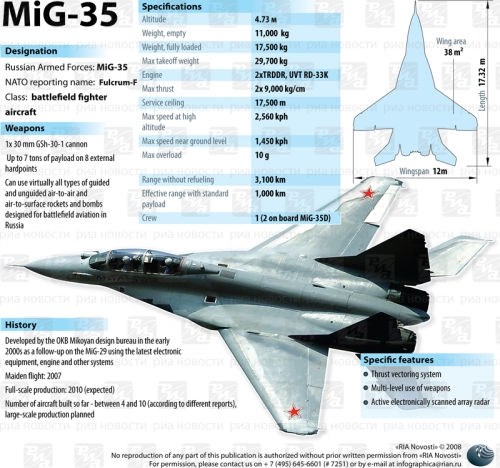
MiG-35: favourite of MMRCA tender 28 August 2007 saw the official kickoff of a largest-scale combat aircraft acquisition tender – the Medium Multi-Role Combat Aircraft (MMRCA) programme estimated at $11 billion and providing for the Indian Air Force to buy 126 medium multirole fighters. On that day, the Indian government issued official request for proposals to the bidders. The preliminary stage shortlisted several contenders for the multibillion-dollar order. Six companies from the United States, Western Europe and Russia indicated their willingness to throw their hats in the ring – Lockheed Martin and Boeing with their F-16 Block 70 and F-18E/F fighters, SAAB offering its Gripen IN, Eurofighter with its EF2000 Typhoon and MiG Corp. with its MiG-35 fighter. According to expert opinion, the Generation 4++ MiG-35 multirole fighter under development by MiG Corp. will become among the favourites of the Indian tender. The MiG-35 demonstrator was derived from the MiG-29M2 prototype two years ago. It was displayed at the Aero India 2007 air show in Bangalore in February 2007, having become one of its zests. At the same time, the US and West European fighters offered by the competitors are very formidable rivals, and a minor upgrade of the current MiG-29 would not be enough to beat them in the tender. Therefore, despite the MiG-35’s similarity of appearance to the current production-standard MiG-29, its design and capabilities embody several drastically novel features attributing the fighter to Generation 4++.
Aero India 2007 was the first time that the final version of the MiG-35 fighter was displayed in an international air show. Previously only the MiG-29OVT prototype of the MiG-35 had been shown to the public at air shows in Russia and the UK in 2006.
It was again demonstrated at Aero India 2009 held at Yelahanka Airbase near Bangalore where it was flown by an Indian Air Force pilot.
By April 2010, pictures and additional info surfaced of two new MiG-35 demonstrators, single-seat MiG-35 bort “961”, and two-seat MiG-35D “967”. According to Russian media, they have first flown at the beginning of Autumn 2009, and subsequently they took part in MMRCA trials in India starting October 2009. Both have a very high commonality with the previous MiG-29K/KUB airframes, with the immediate visible difference being the braking parachute installed in the place of the hook present on the naval aircraft. Subsequently MiG-35D “967” appears to have been equipped with a similar AESA radar as fitted to the older MiG-35 demonstrator bort “154”, identifiable by the dark-grey short nose radome.
In May 2013, it was reported that Russia plans to order 37 aircraft. However, the Russian Defense Ministry reported that the purchase would be delayed on 17 August 2013. The contract will be signed in 2016 for $1.1 billion. The delay was because of problems in drawing up the designs and necessary spending cuts within state arms programs.
In April 2014, it was reported that Egypt plans to order 24 MiG-35 fighters as part of a US$3 billion arms deal
Selection of the Rafale
On 31 January 2012, it was announced that the Dassault Rafale won the competition and has been selected for exclusive negotiations. The reasons given for selection included lower unit cost and lower overall lifecycle cost for the Rafale compared to the Eurofighter due to lower fuel consumption and simpler maintenance requirements. Some reports indicated that EADS may try to re-enter the bid with a lower price quote, but MoD sources ruled out re-entry; the Rafale’s lifecycle cost per unit was about $40 million less than that of the Typhoon. MoD sources also indicated that the final value of MMRCA deal for 126 aircraft (After negotiations) was expected to be about $20–$25 billion.
Defense analysts also point out the operational performance of Rafale during the Libyan bombing campaign and in Afghanistan, the existing experience of the Indian Air Force in operating the French Mirage 2000H during the Kargil War and compatibility with Indian, Israeli, and Russian sub-systems as possible reasons. It was also noted that the recent decision to upgrade India’s Mirage 2000H fighters will simplify the Indian Air Force’s logistics chain. Historical reasons are also considered by analysts to be a potential reason as France was also the only Western nation not to impose sanctions after India tested five nuclear devices in 1998.
Variants
MiG-35: Single-seat variant.
MiG-35D: Two-seat variant.
Specifications
General characteristics
Crew: one or two
Length: 17.3 m (56 ft 9 in)
Wingspan: 12 m (39 ft 4 in)
Height: 4.7 m (15 ft 5 in)
Wing area: 38 m2 (409 ft2)
Empty weight: 11,000 kg (24,250 lb)
Loaded weight: 17,500 kg (38,600 lb)
Max. takeoff weight: 29,700 kg (65,500 lb)
Powerplant: 2 × Klimov RD-33MK afterburning turbofans
Dry thrust: 5,400 kgf, 53.0 kN (11,900 lbf) each
Thrust with afterburner: 9,000 kgf, 88.3 kN (19,800 lbf) each
Performance
Maximum speed: Mach 2.25 (2,400 km/h, 1,491 mph) at altitude; 1,450 km/h (901 mph) at low-level
Range: 2,000 km (1,240 mi)
Combat radius: 1,000 km (620 mi)
Ferry range: 3,100 km (1,930 mi) with 3 external fuel tanks
Service ceiling: 17,500 m (57,400 ft)
Rate of climb: 330 m/s (65,000 ft/min)
Thrust/weight: 1.03
Max. maneuvering load factor: 10.0 g
Armament
Guns: 1× 30 mm GSh-30-1 cannon, 150 rounds
Hardpoints: 9 total (8× under-wing, 1× centre-line) with a capacity of 7,000 kg
Rockets: S-8, S-13, S-24, S-25L, S-250 unguided and laser-guided rockets
Missiles:
Air-to-air:
AA-10 Alamo: 4× R-27R, R-27T, R-27ER, R-27ET
AA-8 Aphid: 4× R-60M
AA-11 Archer: 8× R-73E, R-73M, R-74M
AA-12 Adder: 8× R-77
Air-to-surface:
AS-17 Krypton: 4× Kh-31A, Kh-31P
AS-14 Kedge: 4× Kh-29T, Kh-29L
Bombs:
Guided:
KAB-500L: 500 kg laser-guided bomb
KAB-500T: 500 kg TV-guided bomb
Unguided:
FAB-250: 250 kg bomb
FAB-500: 500 kg bomb
ZAB-500 fuel-air explosive Bomb
Avionics
Phazotron Zhuk AE AESA radar (or other members of the Zhuk radar family)
NII PP OLS-UEM Optical Location station